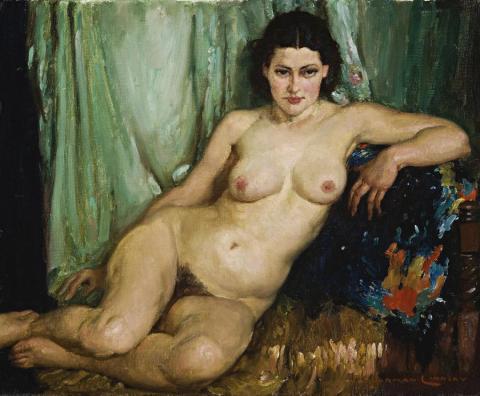A PENSIVE MOOD, c.1935
NORMAN LINDSAY
oil on canvas
53.5 x 66.5 cm
signed lower right: NORMAN LINDSAY
inscribed verso: 448 / A PENSIVE MOOD. / NORMAN. LINDSAY.
Private collection, United States of America
Sotheby's, Melbourne, 19–20 April 1994, lot 55
Private collection, Melbourne
'I've always used a very simple principle to get the best out of my models, and that is to build up their feminine self-esteem by flattery. They burgeon under it. It even affects their colouring, the brightness of their eyes, the assurance with which they take their pose ... Quite apart from the policy of making them feel pleased with themselves, I always felt that I owed them a considerable debt of gratitude. They are a supremely important content of my works.'1
Lindsay's desire for technical excellence across painting, drawing and printmaking was matched by his determination to joyfully and controversially rail against the puritanical. Opposed to the chaste, stylised nudes of the decorative ilk, Lindsay declared, 'I have utterly repudiated the academic nude image of femininity as an innocuous stuffed dummy'.2 Instead, he painted women of vitality, highlighting their self-awareness alongside their sensuality. This is perhaps most evident in his portraits, that don't have the decadent theatricality of his mythically inspired scenes.
Lindsay moved from the Springwood property in the Blue Mountains to his Bridge Street studio in 1934 and there he mastered the luminescent capabilities of oil paint resulting in major works including Spring's Innocence, 1937, in the collection of the National Gallery of Victoria. The present work, with its glowing light, opulent golden and green drapery and technical confidence was likely also painted during these early years at the studio. Although maintaining the Sydney studio until 1956, Lindsay returned in 1941 to Springwood and this was to be his primary residence and creative sanctuary for the remainder of his life.
1. Bloomfield, L., Norman Lindsay Oil Paintings 1889 " 1969, Odana Editions, Sydney, 2006, pp. 4-5
2. Ibid., p. 10
AMY MARJORAM
